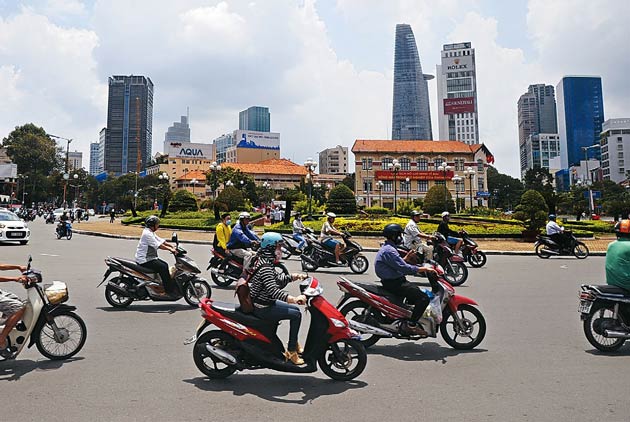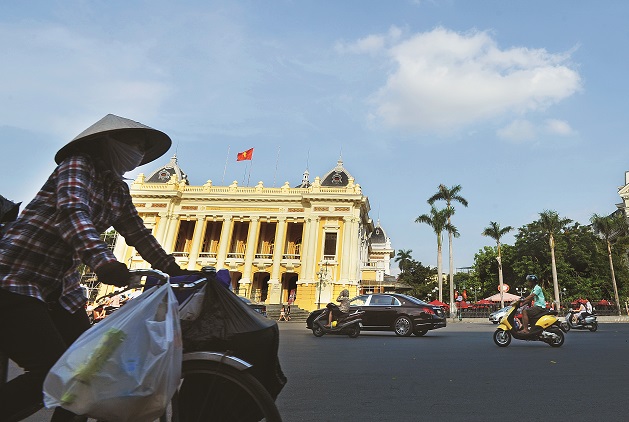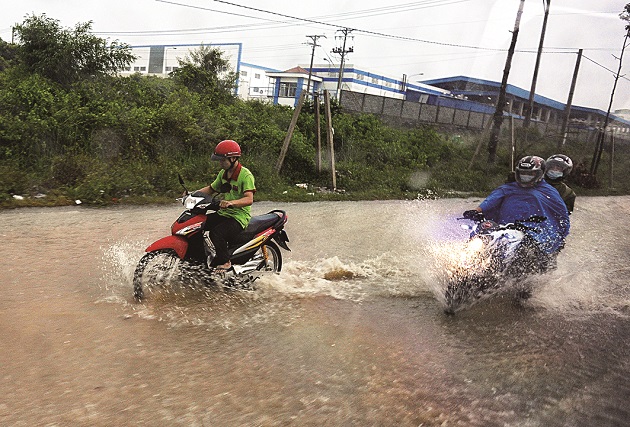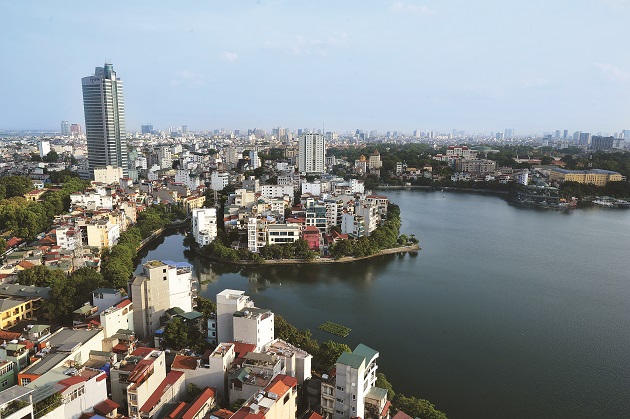Reaping the Benefits of Reforms
Indispensable Vietnam

Source:CW
Vietnam has aggressively engaged in economic reforms and liberalization to prepare for its membership in the Trans-Pacific Partnership and move its economy up the value chain. What new opportunities does that offer Taiwanese businesses?
Views
Indispensable Vietnam
By Kwangyin LiuFrom CommonWealth Magazine (vol. 582 )
Taiwanese yarn maker Tainan Spinning Co., Ltd. has a manufacturing facility in the Bien Hoa Industrial Park in Dong Nai province northeast of Ho Chi Minh City. One August morning, everybody in Tainan Spinning’s facility, from top managers to production line workers, was on their best behavior waiting for a very important guest from Hong Kong.
This VIP customer, based in Guangzhou, is one of Asia’s biggest textile vendors with annual sales of US$500 million, and it purchases more than US$5 million of yarn a year from Tainan Spinning.
In the facility’s VIP meeting room, this thin CEO with a shiny head of hair appears anxious as he sits across from Tainan Spinning’s general manager in Vietnam, Wang Tun-cheng.
“Vietnam will soon join the TPP, with a bright future lying ahead. Tainan Spinning had the foresight to come here 20 years ago. We have no choice but to do the same now,” the CEO said in Mandarin with a Hong Kong accent.
The CEO was in Vietnam representing his conglomerate to study the feasibility of building a plant there. His presence was, in fact, a sign of helplessness. “No matter how much you improve efficiency and automate, it still cannot overcome the power of import duties,” he says with a frown.
Vietnam actually emerged as a key battleground for the global textile industry long ago, and it will likely remain so once the Trans-Pacific Partnership (TPP) comes into being.
The Dividends of Signing FTAs
Because of the TPP’s “yarn forward” principle, for textile products to be given preferential tariff treatment within the TPP bloc, vendors will have to complete all of their processes – from procuring the yarn to knitting and dyeing the fabric – in TPP member countries.
Many Taiwanese companies got an early jump on this and are likely to come out winners. The Far Eastern New Century Group announced at the end of June that it would invest NT$10 billion in Binh Duong province north of Ho Chi Minh City in a 100 hectare factory that will do everything from drawing and spinning yarn to weaving and dyeing fabric.
Eclat Textile Co. and Makalot Industrial Co. are among other Taiwanese textile vendors who have upped their presences in Vietnam.
In the future, the import duties imposed on textiles and clothing made in Vietnam and exported to the United States will gradually fall to zero, while the same items made in non-TPP countries, such as China, will continue to be taxed at a 17 percent rate.
This stark reality has textile vendors in China rushing desperately trying to put wings on their factories and fly them to Vietnam.
The intensifying expeditions of foreign investors to Vietnam are not limited to the textile sector.
Many major Taiwanese vendors in several sectors – textiles, petrochemicals, steel and food – that have invested in Southeast Asia have been concentrated in Vietnam.
They originally invested in Vietnam to take advantage of the country’s low production costs but are now picking up double dividends – they have access to an Association of Southeast Asian Nations common market of 600 million people and their exports will get preferential tariff treatment elsewhere through Vietnam’s portfolio of FTAs (free trade agreements).
“All of Vietnam is pushing for economic growth,” says Taiwan’s representative to Vietnam Huang Chih-peng, who has been stationed in the country for five years after a career with the Taiwan External Trade Development Council.
In an interview with CommonWealth Magazine in his Hanoi office, he described Vietnam’s strengths as “political stability, social stability and calm and collected people.” One reason for the political stability: in Vietnamese elections, the Communist Party picks 99 percent of the candidates.
Huang observes that Vietnam is very skilled diplomatically, cleverly balancing the United States, China, Japan and other big countries as they wrestle for influence in Southeast Asia. Like China, Vietnam is governed by the Communist Party, and the two countries have close relations, but they are also often aloof. Hanoi has gotten close to Washington, but not overly so, maintaining an extremely smart two-pronged strategy.
Vietnam’s economic strategy has focused on reforms and liberalization and joining the U.S.-led TPP process, but it has remained patient in pursuing its goals.
The government has moved aggressively to open its economy and attract foreign investment, primarily from South Korea, Japan, Singapore and Taiwan. But because of Vietnam’s geographical proximity to China and its strategic importance, it can effectively play off the U.S., China and Japan to also obtain considerable amounts of aid.
Among the 10 ASEAN members, Vietnam ranks second behind only Singapore in the number of free trade agreements it has signed with eight. If it completes trade pacts with the European Union and the Eurasian Economic Union, and the TPP and China-led Regional Comprehensive Economic Partnership come into being, about 85 percent of Vietnam’s trade will be covered by FTAs, a percentage similar to South Korea.
In addition, Vietnam will be able to grab opportunities as part of the ASEAN Economic Community (AEC). At the beginning of 2016, the import duties on goods traded within ASEAN will fall to zero (except for tariffs on some agricultural products entering Cambodia, Laos, Vietnam and Myanmar), resulting in the free flow of goods across a 10-country common market of 600 million people with a combined GDP of more than US$2 trillion. It will become the world’s seventh largest economic entity, full of new opportunities for explosive growth.
Leveraging Foreign Investment
Foreign direct investment (FDI) offers a clear picture of Vietnam’s popularity. In 2014, Vietnam attracted US$20.4 billion in FDI, up 30 percent from the previous year.
 In fast-changing Vietnam, the Hanoi Opera House built by the French in the early 1900s is no longer a symbol of colonial authority. Instead, it is part of the Vietnamese capital’s multicultural cityscape.
In fast-changing Vietnam, the Hanoi Opera House built by the French in the early 1900s is no longer a symbol of colonial authority. Instead, it is part of the Vietnamese capital’s multicultural cityscape.
Vietnam also represents the perfect example of leverage. A report in the Financial Times in mid-July compared inbound investment in new factories and stores (called greenfield FDI) in emerging markets relative to the size of each country’s economy, and Vietnam topped the list by a big margin.
According to the Financial Times, a score of 1 “indicates that a country’s share of global inward greenfield FDI matches its relative share of global gross domestic product.” Vietnam had a score of 8.14, meaning that it attracted more than eight times the amount of greenfield FDI than might have been expected given the size of its economy.
Romania was far behind in second with a score of 3.91, followed by Hungary (3.80), Malaysia (3.55) and Thailand (2.47).
South Korea, Japan and Singapore are the three biggest sources of inbound investment in Vietnam, with projects in several fields including electronics, financial services, construction and services.
Of that, South Korea’s Samsung Electronics has invested US$12 billion in the world’s biggest smartphone manufacturing plant with an annual capacity of 120 million handsets in BacNinh province northeast of Hanoi. It is also planning another facility in Thai Nguyen province directly north of the Vietnamese capital.
Once the biggest source of FDI in Vietnam, Taiwan has now fallen back to fourth.
Another important source of foreign investment is “Official Development Assistance,” under which big companies, with the support of their governments, head to Vietnam to build basic infrastructure. Japan and South Korea have been especially aggressive in this area. The first subway line in Ho Chi Minh City, for example, is being built as an Official Development Assistance project, with the Japanese government investing US$2.3 billion and Sumitomo Corporation serving as the project’s designer and main contractor.
China has engaged in similar projects in Vietnam, but they have sparked controversy. Hanoi’s elevated light rail system is being built at a cost of US$8.7 billion by The Sixth Engineering Bureau of China Railway Engineering Corporation and is expected to become operational next year, but it has suffered a spate of accidents during construction, leading to one death and seven people injured.
Aside from lucrative investment opportunities, foreign enterprises covet Vietnam’s market of 92 million people, the third largest in ASEAN. Particularly attractive is the young profile of the population, with 65 percent of Vietnam’s people younger than 35 years old, and their impressive spending power. Though the average monthly salary is only US$200, young Vietnamese everywhere can be seen holding iPhones that cost them three to four months’ salary.
TPP: Forcing Political, Economic Reforms
“In the next five years, the results of Vietnam’s reforms will become increasingly evident,” says Tharabodee Serng-Adichaiwit, the general manager of Bangkok Bank in Vietnam, noting that the country has pushed progressively stronger reforms to prepare for membership in the TPP.
 Flooding is common whenever heavy rains occur, an indication that Vietnam’s infrastructure still has plenty of room for improvement.
Flooding is common whenever heavy rains occur, an indication that Vietnam’s infrastructure still has plenty of room for improvement.
Many Taiwanese businessmen with operations in Vietnam contend that the TPP’s biggest contribution to date has been to force Hanoi to engage in political and economic reforms. The most obvious advances have been improvements in administrative efficiency and statutory revisions and transparency, and the reforms have covered trade, environmental and industrial policies.
“Among the 12 members of TPP, Vietnam is the least developed country. Vietnam could face a lot of challenges as well as many opportunities. We can be more integrated with other countries in ASEAN, but it also mean we need to open our market and deal with competition from other countries,” says Nguyen Huy Hoang, the deputy director of the Vietnam Academy of Social Sciences’ Institute of Southeast Asian Studies.
Consequently, the government, enterprises and the public will face major challenges as the common market takes hold.
One poll found that 76 percent of Vietnamese companies do not understand the AEC, and, of that group, more than six of every 10 companies said it would not influence their operations, the highest percentage of any country in ASEAN.
Nguyen Hoa Huang believes the Vietnamese people need to strengthen their capabilities, pointing to the productivity of Vietnamese workers being only half that of Philippine workers, one-seventh that of Thai workers and one-tenth that of Malaysian workers.
Another trend, he explains, is Vietnam’s growing selectiveness in accepting foreign investment proposals.
“The government now hopes to avoid high pollution, low technology investment, favoring high-tech, high value-added manufacturing. Samsung’s smartphone plant is the best example of that,” Nguyen says.
Vietnam has taken several additional steps this year to further open its market and economy. Beginning in early July, foreign nationals were allowed to own and buy and sell property, and the government in September eliminated the restriction limiting foreign investors to a maximum 49 percent stake in most Vietnamese companies, allowing them 100 percent ownership instead. Only a few areas such as the banking industry were ceilings of 30 percent foreign ownership maintained.
Even tourists can see the determination of Vietnamese authorities in promoting reforms. Flip through Vietnam Airlines’ inflight magazine and one sees an article titled “No pain, no gain” in both Vietnamese and English. It summarized the market opening and wave of liberalization coming to Vietnam once the TPP takes effect and said that despite the many challenges companies will face, they had to bite the bullet and persevere forward.
“There’s no free lunch. To gain fruits in this new arena (textiles), Vietnam will also suffer greater competitive pressure as foreign products can be imported into the country at lower prices,” the article read.
Anxiety was also clearly evident in an English newspaper in Hanoi, in which the lead headline on the front page read, “VN businesses face challenges competing in ASEAN market.”
Another measure: Vietnamese customs authorities plan to simplify export and import documentation by the end of the year to speed up customs clearance procedures, helping improve the competitiveness of local companies.
China Steel: Eyeing a Tariff Edge
Several Taiwanese enterprises have established a presence in Vietnam to maintain their competitive edge, investing nearly US$8 billion (about NT$240 billion) there over the past 25 years.
 Once torn apart by war, Vietnam is now a key base for companies hoping to gain a foothold in the fast-growing ASEAN market.
Once torn apart by war, Vietnam is now a key base for companies hoping to gain a foothold in the fast-growing ASEAN market.
Kaohsiung-based China Steel is a typical example. China Steel Sumikin Vietnam JSC (CSVC) Chairman and General Manager Wong Chao-tung arrived in Vietnam four and a half years ago to supervise the construction of the company’s new factory, China Steel’s biggest overseas investment. The company’s investments totaled nearly US$2.4 billion, including the cold rolled steel plant located in Vung Tau province southeast of Ho Chi Minh City, and a 25 percent stake in the Formosa Plastics Group’s Formosa Ha Tinh Steel Corporation in central Vietnam.
The cooperation between China Steel and the Formosa Plastics Group was motivated by regional economic integration.
“Ha Tinh Steel makes upstream hot-rolled steel, while China Steel makes the high end downstream cold-rolled products. As long as 40 percent of the raw materials are made in Vietnam, we qualify for an ASEAN certificate of origin,” Wong explains.
“Using Vietnam’s FTA opportunities to go after the ASEAN, Indian, European and American markets is really advantageous to us.”
Unfortunately for China Steel, it is facing cutthroat competition from Chinese steel makers, which are dumping their products in the Vietnamese market at prices 20 percent below cost. The day before CommonWealth Magazine interviewed Wong, he was in Hanoi to visit Vietnam’s Ministry of Industry and Trade and join with the Vietnam Steel Association in filing a dumping complaint against Chinese steel products.
“Vietnam is an important beachhead in ASEAN. China Steel wants to help Taiwan blaze a new trail in the region,” Wong says boldly.
Challenges and Competition
Vietnam may be accelerating the pace of its economic opening, but paths of reform are inevitably strewn with perilous risks.
As foreign investment pours into the country, for example, Vietnam’s basic infrastructure is being stretched to the limit, both in terms of institutions and physical infrastructure.
According to a paper presented at a seminar held at the end of August by the Asia Competitiveness Institute, part of the National University of Singapore’s Lee Kuan Yew School of Public Policy, the competitiveness indicators Vietnam most needed to improve were the government bureaucracy, the supervision and soundness of the stock market, road networks, education and inflation.
The more liberalized an economy, the more intense the competition. As Vietnam has slowly evolved from an economy of individual companies into one integrated with ASEAN, companies from other countries have long established beachheads in Vietnam.
“Thai and Malaysian investors have moved aggressively into Vietnam, so companies will have to rely on their true capabilities,” says Vedan International (Holdings) Limited Executive Director and CEO Yang Kun-hsiang.
Amid intense competition, size remains a key asset, but even more important is differentiation.
Because of the stiff competition in the market, Tainan Spinning has decided to join with Eclat Textile and Makalot to shift to higher end products, “because it’s increasingly difficult to turn a profit on products that are not competitive,” says Tainan Spinning’s Wang.
Prospective FTAs and TPP membership have only accentuated the dividends and advantages of Vietnam’s reforms. Companies from around the world are flocking into Vietnam, all with different strategies, and one wonders how Taiwan will find its own strategy. Vietnamese authorities have propagated the message “no pain, no gain” in opening its economy, a lesson that Taiwan might want to consider.
Translated from the Chinese by Luke Sabatier






